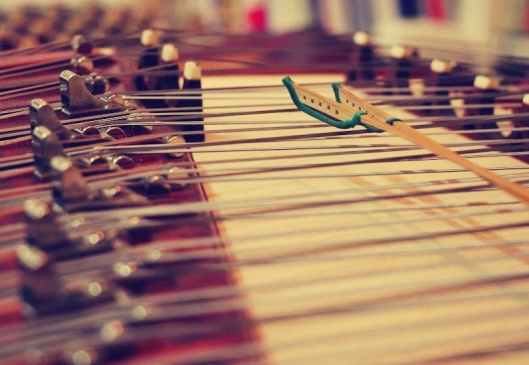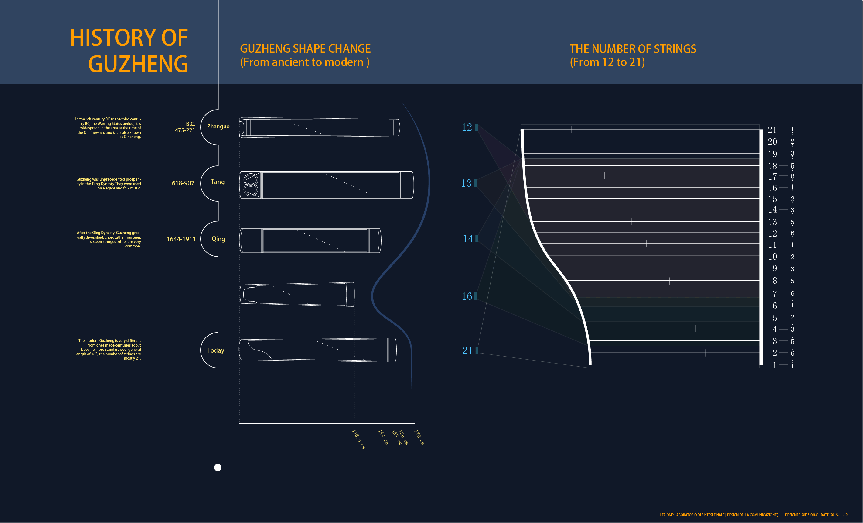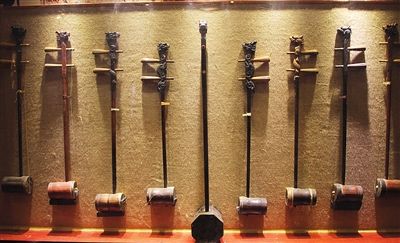By Sari Xu
Silk musical instruments, or nowadays more referred as string instruments, form the biggest category among the Chinese Bayin categories (8 tones), including – silk, bamboo, wood, stone, metal, clay, gourd, and skin. In our previous blogs, we’ve discussed about two large groups of instruments under this category: bowed string family and plucked string family. Other than these two groups, struck string instruments family also plays a very important role here.

The most famous struck string is Yangqin (扬琴), which is sometimes known as Chinese hammered dulcimer. It used to be written as the characters 洋琴, which literally means “foreign zithers”, this is because it was derived from Iranian Santur. Overtime, the first character was changed to “扬”, which means “acclaimed”. Just like other string instruments Pipa, Guzheng, and Erhu, Yangqin and hammered dulcimers of various types are not only famous in China, but also very popular among Eastern Europe, the Middle East, India, Iran, and Pakistan.
In terms of elements of construction, Yangqin also shares a lot of common points with other hammered dulcimers. As a member of the string musical instruments family, the strings are definitely the most significant element. Modern yangqin usually have 144 strings in total, with each pitch running in courses, with up to 5 strings per course, in order to boost the volume. The strings come in various thicknesses, and are tied at one end by screws, and at the other with tuning pegs. The pegs and screws are covered during playing by a hinged panel/board. This panel is opened up during tuning to access the tuning pegs.
Interestingly, though older Chinese string musical instruments used silk strings, which later formed the category as “silk instruments”, Yangqin, as one of the representative of Jiangnan Sizhu (江南丝竹, Silk and bamboo genre in Shanghai region), was traditionally fitted with bronze strings!

The design of bridges on a yangqin is also a piece of art and more complicated than the bridges on a modern guitar from my opinion. There are usually four to five bridges on a yangqin called bass bridge, “right bridge”, tenor bridge, “left bridge”, and the chromatic bridge, respectively from right to left. During playing, one is supposed to strike the strings on the left side of the bridges. However, the strings on the “chromatic bridge” are struck on the right, and strings on the “left bridge” can be struck on both sides of the bridge.
Hammers are the most unique element of a yangqin and what form the “struck instrument” category. They are mostly made of another commonly used material in traditional Chinese music – bamboo! One end of the hammers is half covered by rubber. This brings two ways of playing the yangqin: with the rubber side for a softer sound, and with the bamboo side for a crisper, more percussive sound. This technique, known as 反竹(Fan Zhu), is best utilized in the higher ranges of the yangqin.Additionally, the ends of the sticks can be used to pluck the strings, producing a sharp, clear sound. Glissandos can also be achieved in this way by running the ends of the sticks up or down the strings! This means, once the player reaches the professional level of playing the yangqin, he or she could play this instrument as a yangqin, a guzheng, and a pipa at the same time!

Other than the yangqin, Zhu (筑)was also a famous struck string instrument back at the ancient time though it’s no longer used. The instrument remained popular through the Sui and Tang dynasties (581 – 907), and was lost during the Song Dynasty (960 – 1276).


Now, let’s enjoy one of the traditional music pieces played by a yangqin soloist!
About Interact China
“A Social Enterprise in E-commerce Promoting Oriental Aesthetic Worldwide!”
Aileen & Norman co-founded Interact China in 2004 with specialization in fine Oriental Aesthetic products handmade by ethnic minorities & Han Chinese. Having direct partnerships with artisans, designers, craft masters and tailors, along with 15 years of solid experience in e-commerce via InteractChina.com, we are well positioned to bridge talented artisans in the East with the rest of the world, and directly bring you finely selected products that are of good quality and aesthetic taste.
So far we carry 3000+ goods covering Ladies Fashion via ChineseFashionStyle.com, Kungfu Fashion, Home Furnishings, Babies & Kids, Painting Arts, Textile Arts, Carving Arts, Tribal Jewelry Art, Wall Masks and Musical Instruments. Our team speak English, French, German, Spanish and Italian, and serve customers worldwide with passion and hearts.
P.S. We Need People with Similar Passion to Join Our Blogging Team!
If you have passion to write about Oriental Aesthetic in Fashion, Home Decor, Art & Crafts, Culture, Music, Books, and Charity, please contact us at bloggers@interactchina.com, we would love to hear from you!





































 A fiddle with a soundboard of stretched skin. The largest of the Uyghur Ghijäk is found amongst the Dolan, with one horse-hair melodic string and several metal sympathetic strings. The Qumul Ghijäk has two bowed strings tuned a fifth apart, and six to eight sympathetic strings. The earliest Chinese historical records relate that a bowed instrument strung with horse-hair was played in the Qumul region, but the contemporary instrument is probably a fairly recent hybrid between the Chinese Erhu fiddle and the Uyghur Ghijäk , testament to the Chinese cultural influence in this easternmost point of Xinjiang. The Ghijäk now played by professional musicians was adapted in the 1950s, today its four metal strings are tuned like the violin but its playing technique is closer to the Iranian spike fiddle, held on the knee, the bow is held loosely in the hand, palm upwards, and the strings are pressed against the bow by pivoting the instrument. This Ghijäk is also found in soprano and tenor versions.
A fiddle with a soundboard of stretched skin. The largest of the Uyghur Ghijäk is found amongst the Dolan, with one horse-hair melodic string and several metal sympathetic strings. The Qumul Ghijäk has two bowed strings tuned a fifth apart, and six to eight sympathetic strings. The earliest Chinese historical records relate that a bowed instrument strung with horse-hair was played in the Qumul region, but the contemporary instrument is probably a fairly recent hybrid between the Chinese Erhu fiddle and the Uyghur Ghijäk , testament to the Chinese cultural influence in this easternmost point of Xinjiang. The Ghijäk now played by professional musicians was adapted in the 1950s, today its four metal strings are tuned like the violin but its playing technique is closer to the Iranian spike fiddle, held on the knee, the bow is held loosely in the hand, palm upwards, and the strings are pressed against the bow by pivoting the instrument. This Ghijäk is also found in soprano and tenor versions.







 The neck is often highly decorated with inlay bone or black and white plastic nowadays in squares, triangles, lines. The top of the ribs have triangle inlays, together forming a kind of wind rose. The entire instrument except the front is varnished.
The neck is often highly decorated with inlay bone or black and white plastic nowadays in squares, triangles, lines. The top of the ribs have triangle inlays, together forming a kind of wind rose. The entire instrument except the front is varnished.


 Ghidjak is the only bow instrument found in the Pamirs. Ghijek is usually carved from the wood of an apricot tree. Very thin wood covers the bowl, and cowhide is stretched inside the drum as a sound table. The bowl has many holes, to make the sound more resonant, and it is adorned with colorful ornaments. Its sound box is metal or wooden, and it has three or four metal strings and a neck made of willow, apricot or mulberry wood. It is tuned in intervals of fourths. The sound box is carved out of a single piece of wood. The upper orifice is partly covered in the middle by the handle and the lower one is covered by a skin membrane against which rest the bridge. The bow is made of horsehair and tied to a curved stick.
Ghidjak is the only bow instrument found in the Pamirs. Ghijek is usually carved from the wood of an apricot tree. Very thin wood covers the bowl, and cowhide is stretched inside the drum as a sound table. The bowl has many holes, to make the sound more resonant, and it is adorned with colorful ornaments. Its sound box is metal or wooden, and it has three or four metal strings and a neck made of willow, apricot or mulberry wood. It is tuned in intervals of fourths. The sound box is carved out of a single piece of wood. The upper orifice is partly covered in the middle by the handle and the lower one is covered by a skin membrane against which rest the bridge. The bow is made of horsehair and tied to a curved stick.

 In the old days Rawap is faced with horse or donkey hides. Today, however, snake skin is used for the highest quality Rawap , while Ox skin is also commonly used.
In the old days Rawap is faced with horse or donkey hides. Today, however, snake skin is used for the highest quality Rawap , while Ox skin is also commonly used. The body and the beginning of the neck is carved from one piece of mulberry wood, in a kind of half coconut shape, with two bended horn-like extensions at both sides at the beginning of the neck. The front is covered with a thick skin, often made of python skin. The long half round neck is joined by a V-join to the horns. The frets are tied-on nylon in 3-double windings in an almost chromatic scale. At the left side of the neck is a groove.
The body and the beginning of the neck is carved from one piece of mulberry wood, in a kind of half coconut shape, with two bended horn-like extensions at both sides at the beginning of the neck. The front is covered with a thick skin, often made of python skin. The long half round neck is joined by a V-join to the horns. The frets are tied-on nylon in 3-double windings in an almost chromatic scale. At the left side of the neck is a groove.